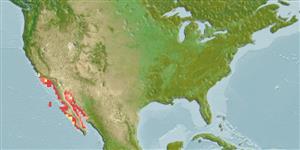Common names from other countries
>
Eupercaria/misc (Various families in series Eupercaria) >
Haemulidae (Grunts) > Haemulinae
Etymology: Anisotremus: Greek, anisos = unequal + Greek, trema, -atos = hole (Ref. 45335).
More on author: Steindachner.
Environment: milieu / climate zone / depth range / distribution range
Écologie
marin démersal; profondeur 0 - 40 m (Ref. 2850), usually ? - 8 m (Ref. 2850). Subtropical; 39°N - 22°N, 124°W - 106°W
Eastern Central Pacific: Santa Cruz in central California, USA to southern Baja California, Mexico; isolated population in the Gulf of California.7
Taille / Poids / Âge
Maturity: Lm ? range ? - ? cm
Max length : 58.0 cm TL mâle / non sexé; (Ref. 2850); âge max. reporté: 15 années (Ref. 56049)
Occur in coastal waters, frequently in rocky reefs and occasionally over sandy bottoms (Ref. 9114); often near kelp beds. Juveniles form schools in littoral pools (Ref. 9114). Feed on crustaceans, mollusks and bryozoans. Pelagic spawner (Ref. 56049). Marketed fresh (Ref. 9114).
Distinct pairing during breeding (Ref. 205). Pelagic spawner (Ref. 56049).
Eschmeyer, W.N., E.S. Herald and H. Hammann, 1983. A field guide to Pacific coast fishes of North America. Boston (MA, USA): Houghton Mifflin Company. xii+336 p. (Ref. 2850)
Statut dans la liste rouge de l'IUCN (Ref. 130435)
CITES (Ref. 128078)
Not Evaluated
Menace pour l'homme
Harmless
Utilisations par l'homme
Pêcheries: intérêt commercial mineur; pêche sportive: oui
Plus d'informations
RéférencesAquacultureProfil d'aquacultureSouchesGénétiqueElectrophoresesHéritabilitéPathologiesTraitementMass conversion
CollaborateursImagesStamps, Coins Misc.SonsCiguateraVitesseType de nageSurface branchialeOtolithesCerveauxVision
Outils
Articles particuliers
Télécharger en XML
Sources Internet
Estimates based on models
Preferred temperature (Ref.
115969): 15.2 - 23.3, mean 21.1 (based on 116 cells).
Phylogenetic diversity index (Ref.
82804): PD
50 = 0.5039 [Uniqueness, from 0.5 = low to 2.0 = high].
Bayesian length-weight: a=0.01738 (0.00807 - 0.03743), b=3.02 (2.83 - 3.21), in cm Total Length, based on LWR estimates for this (Sub)family-body shape (Ref.
93245).
Niveau trophique (Ref.
69278): 3.5 ±0.46 se; based on food items.
Résilience (Ref.
120179): Milieu, temps minimum de doublement de population : 1,4 à 4,4 années (tm=2; tmax=15).
Fishing Vulnerability (Ref.
59153): Moderate vulnerability (43 of 100).
